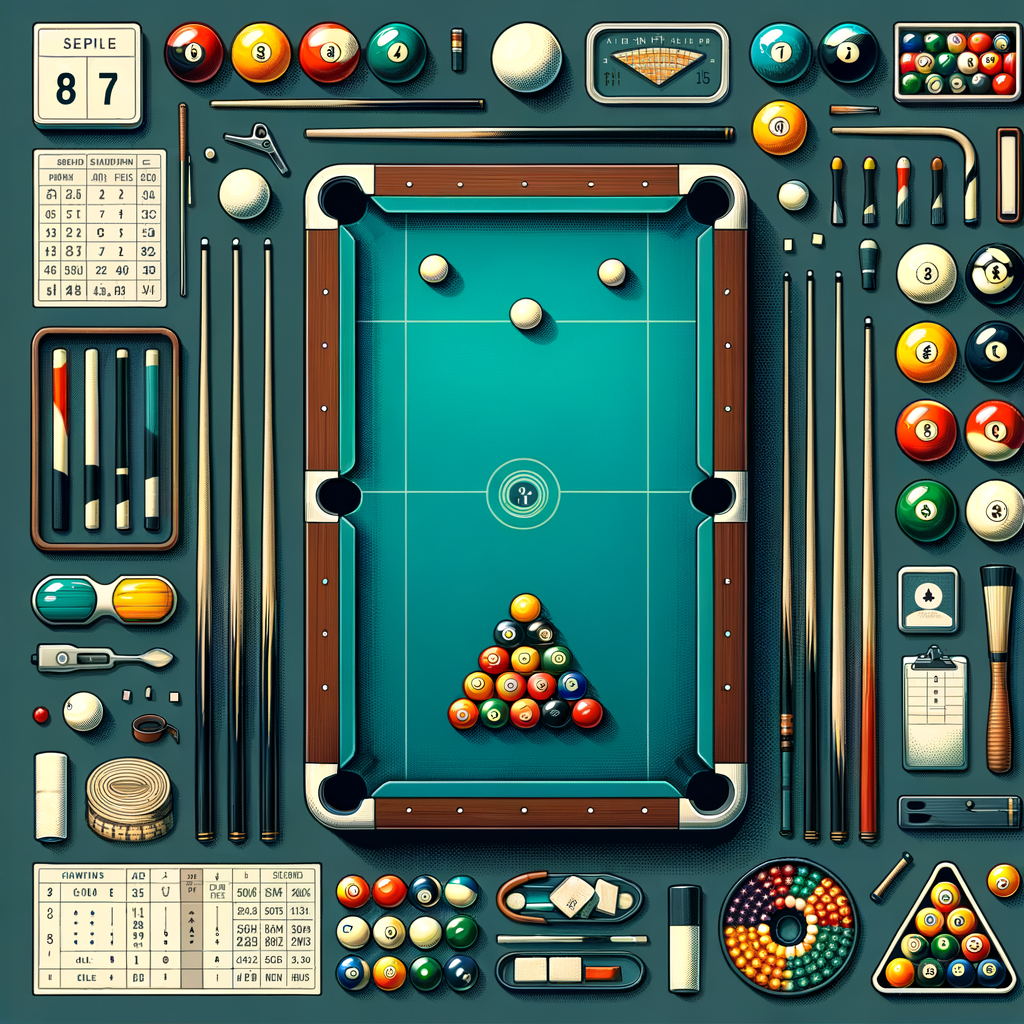
Introduction to Billiards
Welcome to the fascinating world of billiards! This game, often seen in recreation rooms and sports bars, is much more than just a casual pastime. It has a rich history and a wide following. Let’s dive into the details.
-
Definition of Billiards
Billiards, also known as cue sports, is a broad term that covers a variety of games played on a table with balls and a cue stick. The objective varies depending on the type of game, but generally, players use the cue stick to strike the balls, aiming to pocket them or position them in a specific way on the table.
-
History of Billiards
Billiards has a long and storied history. It was first played in the 15th century in Europe, and it was initially an outdoor game similar to croquet. Over time, it moved indoors and onto the table. The game has evolved significantly since then, with different versions like pool, snooker, and carom billiards emerging.
-
Popularity of Billiards
Today, billiards is enjoyed by millions of people worldwide. It’s not just a game for leisure; it’s also a professional sport with tournaments held globally. According to the Billiard Congress of America, there are over 46 million people in the United States alone who play billiards regularly. Its popularity is a testament to the game’s appeal, combining strategy, skill, and a bit of luck.
Now that we’ve covered the basics, we’ll delve into the different types of billiards games, their key differences, and some tips and strategies to improve your game. Stay tuned!
Understanding Billiards: The Basics
Before we delve into the various types of billiards games, it’s essential to understand the basics. The game of billiards, whether it’s pool, snooker, or carom, revolves around three main elements: the table, the balls, and the cue. Let’s break down each of these components.
-
The Billiards Table
The billiards table is a large, rectangular table covered in green felt. The size can vary depending on the type of billiards game you’re playing. For example, a standard pool table is 9 feet long, while a snooker table can be as long as 12 feet. The table is surrounded by rubber cushions that allow the balls to bounce off the sides. Most tables also have six pockets, one in each corner and two along the middle of the longest sides, where the balls are supposed to be shot into.
-
The Billiards Balls
Billiards balls are small, hard spheres used in the game. In a standard game of pool, there are 16 balls: one white cue ball and 15 object balls. The object balls are divided into two groups: seven solid-colored balls and seven striped balls, plus an 8-ball which is black. In snooker, there are 21 balls: one white cue ball, 15 red balls, and five balls of different colors. The goal is to strike the cue ball with the cue, causing it to hit other balls and knock them into the pockets.
-
The Billiards Cue
The cue is a long, tapered stick used to strike the cue ball. It’s typically made of wood, but can also be made of other materials like fiberglass or carbon fiber. One end of the cue is thicker and has a grip for holding, while the other end is thinner and ends in a tip, usually made of leather, which is used to hit the ball. The cue is a crucial tool in the game of billiards, as the player’s skill in handling the cue can greatly affect their performance in the game.
Understanding these basic elements is the first step towards mastering the game of billiards. In the following sections, we’ll explore the different types of billiards games, their key differences, and some tips and strategies to improve your game.
Types of Billiards Games
Carom Billiards
- Overview of Carom Billiards
Carom Billiards, also known as French Billiards, is a type of billiards game that is played on a table without pockets. The game originated in France and is one of the oldest forms of billiards. Unlike other billiards games, Carom Billiards focuses on the player’s ability to ‘carom’ off both the other balls on the table with a single shot. This unique aspect makes Carom Billiards a challenging and exciting game to play. - Rules of Carom Billiards
The rules of Carom Billiards are quite simple. The game is played with three balls; two are white and one is red. One of the white balls is marked with a dot to distinguish it from the other. The objective is to strike your opponent’s balls in a single shot. A player scores a point each time their cue ball hits the other two balls. The player with the most points at the end of the game wins. Remember, the balls must be hit in a specific order and the cue ball must always hit the other two balls in a single shot. - How to Play Carom Billiards
Playing Carom Billiards requires a good understanding of angles and precision. The game begins with the balls placed in a particular order on the table. The player then uses the cue stick to hit the cue ball aiming to strike the other two balls. It’s important to plan your shots in advance and consider the potential caroms that could occur. With practice and strategy, you can master the art of Carom Billiards and enjoy this classic game.
Pool Billiards
Pool billiards, commonly known as pool, is a popular type of billiards game enjoyed by millions worldwide. It’s a game that requires both strategy and skill, and it’s a fun way to spend time with friends and family.
-
- Overview of Pool Billiards
Pool billiards is a cue sport that originated in the 15th century. It’s played on a rectangular table with six pockets – one at each corner and one in the middle of each long side. The game involves hitting a white cue ball to pot other balls into the pockets. Depending on the specific game variant, the objective might be to pot balls in a specific order or simply to pot more balls than your opponent.
-
- Rules of Pool Billiards
While there are many variations of pool, the general rules are similar. Players take turns to strike the cue ball and aim to pot other balls into the pockets. A player’s turn continues as long as they keep potting balls. If a player fails to pot a ball or commits a foul, their turn ends. The game continues until a player has potted all their designated balls and the black ball, or until a player is declared the winner based on the specific game rules.
-
- How to Play Pool Billiards
Playing pool billiards involves a few simple steps. First, the balls are racked at one end of the table, with the apex ball placed on the foot spot. The opening shot, or break, is then made. The players then take turns to strike the cue ball and attempt to pot other balls. The player who pots all their designated balls and the black ball first, without committing any fouls, wins the game.
Pool billiards is a game that combines skill, strategy, and a little bit of luck. Whether you’re a seasoned pro or a beginner, it’s a game that can provide hours of entertainment. So why not grab a cue, chalk up, and give it a try?
Snooker
Snooker is a fascinating and strategic game that is part of the billiards family. It’s known for its precision, tactics, and the unique challenge it presents to its players.
- Overview of SnookerSnooker, originating in India during the British colonial rule, is a cue sport that is played on a rectangular table covered in green baize. The table is marked with pockets situated in each of the four corners and the middle of each of the long side cushions. The game involves 21 colored balls and a white cue ball. The objective is to score more points than your opponent by potting balls in a specific order.
- Rules of SnookerThe rules of snooker are a bit more complex than other billiards games. The game begins with the balls arranged in a specific order. Players take turns striking the cue ball to pot the other balls in a predetermined sequence, starting with the red balls, then a colored ball, and so on. Each type of ball has a different point value. A player’s turn continues as long as they keep potting the correct ball, but ends if they fail to pot a ball, pot the wrong ball, or commit a foul. The game ends when all the balls have been potted in the correct order, or it becomes impossible for the other player to win with the remaining balls.
- How to Play SnookerPlaying snooker involves a combination of strategy, precision, and a good understanding of angles. Here’s a simple step-by-step guide:
- Start by setting up the balls in the correct order on the table.
- Decide who goes first. The first player aims the cue ball at the red balls to try and pot one.
- If a red ball is potted, the player earns one point and can then aim for a colored ball. The colored balls have different point values ranging from two to seven.
- If the player pots the correct ball, they continue their turn. If they fail to pot a ball or pot the wrong ball, their turn ends and the other player gets a chance to play.
- The game continues in this way until all the balls have been potted in the correct order, or it becomes impossible for one player to win with the remaining balls on the table.
Snooker is a game of patience and strategy. It requires a keen eye, a steady hand, and a good understanding of geometry and physics. It’s a game that can be enjoyed by people of all ages and skill levels, and it’s a great way to improve your concentration and strategic thinking skills.
Billiards Games Explained: Key Differences
Billiards is a popular game played all around the world. However, it’s not just one game. There are several different types of billiards games, each with its own unique rules and strategies. In this section, we will explore the key differences between Carom, Pool, and Snooker, and also debunk some common misconceptions about these games.
- Carom vs Pool vs Snooker
While all three games are played on a billiard table with cues and balls, there are significant differences between them.
| Game | Table Size | Number of Balls | Main Objective |
|---|---|---|---|
| Carom | 10 feet | 3 | Hit both the other balls with the cue ball in a single shot |
| Pool | 7-9 feet | 9 or 15 | Pot balls into pockets in a specific order or before your opponent |
| Snooker | 12 feet | 21 | Score more points than your opponent by potting balls in a specific order |
As you can see, each game has its own unique set of rules and objectives, making each one a unique challenge.
- Common Misconceptions about Different Billiards Games
There are many misconceptions about billiards games. One common misconception is that all billiards games are the same. As we’ve just seen, this is not true. Each game has its own unique set of rules and strategies.
Another common misconception is that billiards is a game of luck. While there is an element of luck involved, like in any game, the key to winning at billiards is skill and strategy. Understanding the rules, practicing your shots, and learning to think several moves ahead can greatly improve your game.
Finally, some people believe that billiards is a game only for adults. This is also not true. Billiards is a game that can be enjoyed by people of all ages. In fact, many professional billiards players started learning the game when they were children.
Understanding the differences between these games and debunking these misconceptions can help you appreciate the skill and strategy involved in billiards, and might even inspire you to pick up a cue and try it for yourself.
Billiards Games Demystified: Tips and Strategies
Billiards is a game of skill, strategy, and precision. To become a proficient player, you need to understand and master a few key aspects. Here, we will demystify the game and provide tips and strategies to help you improve.
- Improving Your Aim
Good aim is crucial in billiards. It’s not just about hitting the ball; it’s about hitting it in the right direction. Here are a few tips to help you improve your aim:
Practice: The more you play, the better your aim will become. Make it a habit to practice regularly.
Focus: Concentrate on the ball and the pocket you want to hit. Visualize the path the ball should take before you make your shot.
Stance: Your stance can affect your aim. Stand with your feet shoulder-width apart and align your body with the shot.
- Mastering the Break
The break is the first shot in a game of billiards, and it can set the tone for the rest of the game. Here’s how you can master the break:
Power: A powerful break can scatter the balls across the table, increasing your chances of sinking a ball.
Accuracy: Aim for the center of the rack. A well-aimed break can give you control over the game.
Control: Don’t just focus on power. Control is equally important. A controlled break can prevent the cue ball from bouncing off the table.
- Understanding Spin and English
Spin and English refer to techniques used to control the path of the cue ball after it hits another ball. Here’s what you need to know:
Top Spin: Hitting the cue ball above center can make it move forward after hitting another ball.
Back Spin: Hitting the cue ball below center can make it move backward after hitting another ball.
Side Spin: Hitting the cue ball to the left or right of center can make it move sideways after hitting another ball.
Mastering these techniques can give you an edge in the game. Remember, practice makes perfect. So, grab your cue and start practicing!
Conclusion: The Universal Appeal of Billiards
As we wrap up our exploration of billiards, it’s clear that this game has a universal appeal that transcends borders and cultures. Let’s delve into why billiards is loved globally and what the future holds for this beloved game.
-
- Why Billiards is Loved Globally
Billiards, in its various forms, is a game that has been enjoyed by millions of people worldwide. Its appeal lies in its simplicity and the strategic depth it offers. Anyone can pick up a cue and start playing, but mastering the game requires skill, strategy, and a deep understanding of the physics involved.
Moreover, billiards is a social game. It’s a great way to bond with friends, meet new people, and even compete in friendly matches. The game also transcends age barriers, making it a popular choice for family gatherings and social events.
Lastly, the game of billiards is a universal language. No matter where you are in the world, the rules of the game remain the same. This global understanding and love for the game have made billiards a universally appreciated pastime.
-
- The Future of Billiards
Looking ahead, the future of billiards seems bright. With advancements in technology, we’re seeing more interactive and immersive billiards experiences. Virtual reality (VR) and augmented reality (AR) are bringing the game to new audiences and providing unique ways to play and learn.
Furthermore, the rise of professional billiards competitions and televised matches is increasing the game’s visibility and popularity. Young players are being inspired to take up the game, ensuring a new generation of billiards enthusiasts.
In conclusion, billiards is more than just a game; it’s a global phenomenon that brings people together. Its universal appeal and promising future ensure that it will continue to be loved and played for generations to come.














